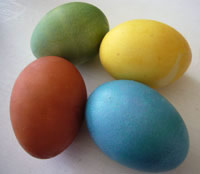| SiGN UP! join
the DigsNews mailing list + we'll keep you posted about updates and other DIGS-related news .
|
|
|
|
| .. |
need
party help?
Jump
to the boards
and talk
about entertaining, cooking, etiquette and more.
|
copyright ©1999-2007
DigsMagazine.com. |
egg me on natural
easter egg dyeing
by Yee-Fan Sun | 1 2 3 4
continued from page 1
.
to
dye for
Scouring online, I’d found a basic “recipe” for making natural dyes, along
with all sorts of suggestions for materials. Thus armed with this knowledge,
I promptly proceeded to make a list of the materials that sounded most
interesting. Besides the onion peels (which I scrounged up from the loose
onions bin at my supermarket, then popped into a bag along with a couple
of whole onions to buy), I decided to try red cabbage leaves (which oddly
enough, was supposed to yield a robin’s egg blue dye), turmeric (yellow),
beets (pink), and golden delicious apple peels (greenish-yellow). Red zinger
tea was supposed to yield a pretty lavender color, but sadly, my supermarket
didn’t seem to stock it; instead, I threw a box of cheap cranberry tea
into the shopping cart. |
the
basic recipe
Here’s a rough suggestion for proportions…
4 cups
vegetable/fruit material, 1 Tbsp. spice, or 6 tea bags
5 or
so cups water (enough to cover the dye material)
2 Tbsp.
vinegar
|
Both the fun and
frustration of natural dyes is that colors and results can be a little
unpredictable. Amazingly, the red cabbage leaves really did leave
the eggs a beautiful blue, despite the fact that the dye itself looked
purple. The beets, meanwhile, yielded a gorgeous magenta dye, but
even after overnight soaking, the dye hadn’t seemed to really penetrate.
Instead, the eggs were left a speckled pinkish-gray – a subtle, more
naturalistic look. The golden delicious peels, meanwhile, were a
complete bust, generating almost no discernable color beyond a vague
blah gray. The cranberry tea also seemed to make the eggs go gray
rather than the expected reddish-pink. The real winners in terms
of color punch? Red cabbage leaves, ground turmeric, and brown onion
skins.
 best
dyes to try best
dyes to try
- Brown/yellow
onion skins – bright orange to red-brown
- Red
cabbage leaves – beautiful brilliant blue
- Ground
turmeric – rich lovely yellow
Bear in mind that
you can get different colors by adjusting the amount of dyeing time,
as well as dyeing in two different colors (let the eggs dry between
coats).
don't stop: there's more!
---------------------------> lounge . nourish . host . laze . home .
|

